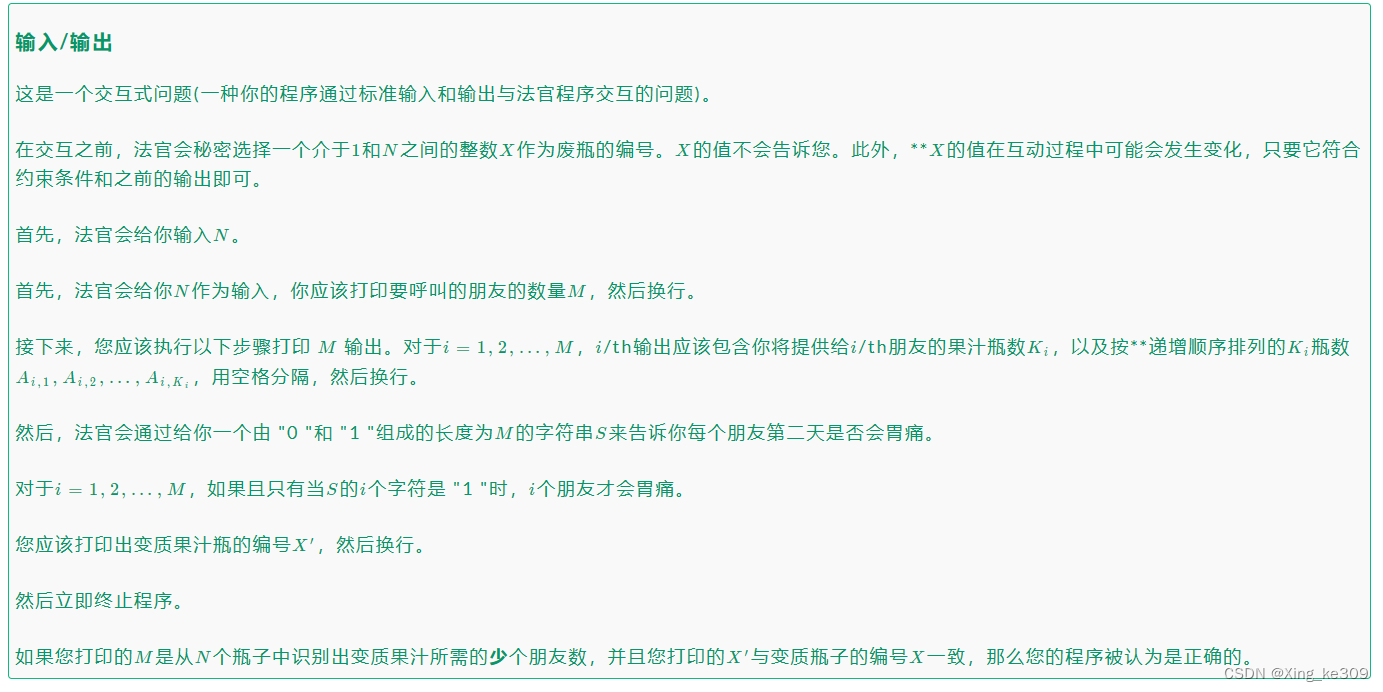
 解题思路
解题思路
- 由于最后返回一个01字符串表示所选人的状态
- 要求人数最少,即字符串长度最少
- 而要用最少的字符,找出
- 则返回的字符为二进制下
的编号
- 这样利用了所有的01字符
号人表示二进制下
位的情况
- 注意对于2的次方项
,只需要有
位,
可以用
位均为0表示
import java.io.*;
import java.math.BigInteger;
import java.util.Arrays;
import java.util.BitSet;
import java.util.HashMap;
import java.util.HashSet;
import java.util.Iterator;
import java.util.LinkedList;
import java.util.Map;
import java.util.Objects;
import java.util.PriorityQueue;
import java.util.Queue;
import java.util.Random;
import java.util.Scanner;
import java.util.Stack;
import java.util.StringTokenizer;
import java.util.Vector;
public class Main{
static long md=(long)998244353;
static long Linf=Long.MAX_VALUE/2;
static int inf=Integer.MAX_VALUE/2;
static
class Node{
int x;
int y;
public Node(int u,int v) {
x=u;
y=v;
}
}
public static void main(String[] args) throws IOException{
// AReader input=new AReader();
// PrintWriter out = new PrintWriter(new OutputStreamWriter(System.out));
Scanner input=new Scanner(System.in);
int n=input.nextInt();
//返回的二进制字符串即为变质的编号
int t=0;
while((1<<t)<n)t++;
System.out.println(t);
int[] c=new int[n+1];
for(int i=0;i<t;++i) {
for(int j=1;j<=n;++j) {
if(((j>>i)&1)==1)c[i]++;
}
}
for(int i=0;i<t;++i) {
System.out.print(c[i]);
for(int j=1;j<=n;++j) {
if(((j>>i)&1)==1)System.out.print(" "+j);
}
System.out.println();
}
String string=input.next();
char[] s=string.toCharArray();
int ans=0;
for(int i=0;i<t;++i) {
if(s[i]=='1')ans|=(1<<i);
}
if(ans==0)ans=n;
System.out.println(ans);
System.out.flush();
// out.flush();
// out.close();
}
//System.out.println();
//out.println();
static
class AReader{
BufferedReader bf;
StringTokenizer st;
BufferedWriter bw;
public AReader(){
bf=new BufferedReader(new InputStreamReader(System.in));
st=new StringTokenizer("");
bw=new BufferedWriter(new OutputStreamWriter(System.out));
}
public String nextLine() throws IOException{
return bf.readLine();
}
public String next() throws IOException{
while(!st.hasMoreTokens()){
st=new StringTokenizer(bf.readLine());
}
return st.nextToken();
}
public char nextChar() throws IOException{
//确定下一个token只有一个字符的时候再用
return next().charAt(0);
}
public int nextInt() throws IOException{
return Integer.parseInt(next());
}
public long nextLong() throws IOException{
return Long.parseLong(next());
}
public double nextDouble() throws IOException{
return Double.parseDouble(next());
}
public float nextFloat() throws IOException{
return Float.parseFloat(next());
}
public byte nextByte() throws IOException{
return Byte.parseByte(next());
}
public short nextShort() throws IOException{
return Short.parseShort(next());
}
public BigInteger nextBigInteger() throws IOException{
return new BigInteger(next());
}
public void println() throws IOException {
bw.newLine();
}
public void println(int[] arr) throws IOException{
for (int value : arr) {
bw.write(value + " ");
}
println();
}
public void println(int l, int r, int[] arr) throws IOException{
for (int i = l; i <= r; i ++) {
bw.write(arr[i] + " ");
}
println();
}
public void println(int a) throws IOException{
bw.write(String.valueOf(a));
bw.newLine();
}
public void print(int a) throws IOException{
bw.write(String.valueOf(a));
}
public void println(String a) throws IOException{
bw.write(a);
bw.newLine();
}
public void print(String a) throws IOException{
bw.write(a);
}
public void println(long a) throws IOException{
bw.write(String.valueOf(a));
bw.newLine();
}
public void print(long a) throws IOException{
bw.write(String.valueOf(a));
}
public void println(double a) throws IOException{
bw.write(String.valueOf(a));
bw.newLine();
}
public void print(double a) throws IOException{
bw.write(String.valueOf(a));
}
public void print(char a) throws IOException{
bw.write(String.valueOf(a));
}
public void println(char a) throws IOException{
bw.write(String.valueOf(a));
bw.newLine();
}
}
}




 文章讲述了如何使用Java编程语言中的Scanner和二进制操作来表示和查找特定条件下的人数编号问题,通过二进制位表示法找到最少字符的01字符串,以表示给定条件下的编号。
文章讲述了如何使用Java编程语言中的Scanner和二进制操作来表示和查找特定条件下的人数编号问题,通过二进制位表示法找到最少字符的01字符串,以表示给定条件下的编号。
















 1918
1918

 被折叠的 条评论
为什么被折叠?
被折叠的 条评论
为什么被折叠?








